Physical Address
304 North Cardinal St.
Dorchester Center, MA 02124
Image-guided drainage is an established technique with a multitude of applications. However, the indications, techniques and management of image-guided catheter drainage continue to evolve. Percutaneous drainage is now the technique of choice for the drainage of abscesses in most locations. Abscesses in challenging locations, which were previously managed by surgical intervention, are now often drained percutaneously. Ninety-seven per cent of intra-abdominal abscesses are currently drained percutaneously. In 2001, only 63% of abscesses were drained by this route. This chapter provides an overview of the principles of image-guided drainage. We also discuss important technical aspects of specific drainage procedures, how to care for a drainage catheter and potential complications that can arise.
As a general rule, image-guided drainage is indicated for the treatment of an accessible collection in a suitable patient who does not require immediate surgical intervention (or to avoid surgery), to obtain a fluid sample for diagnostic purposes, or to relieve symptoms. Image-guided drainage alone is sometimes sufficient for the treatment of a collection, but it can also act as an adjunct or temporising measure before definitive surgical treatment. Drainage of a symptomatic collection such as an abscess is performed in order to drain pus from the cavity, working in conjunction with antibiotics (and to allow microbiological assessment of the abscess fluid for directed antibiotic therapy). Infected collections accumulate antibiotics to a limited extent, which generally precludes effective treatment with antibiotics alone, unless the collection is very small (1 to 3 cm). Antibiotic coverage is necessary for many drainage procedures, even if the collection is not infected, to reduce the chance of secondarily infecting the collection. Examples of non-infected symptomatic collections that often require drainage include hydronephrosis caused by ureteric obstruction, a postoperative seroma, urinoma and haematoma. Diagnostic fluid samples help to determine whether a collection is infected and may also help to identify the source of a collection. Fluid should be analysed by a Gram stain; culture and sensitivity analysis should also be performed. Analysis of the cell count is also useful to quantify the number of white cells in a sample. Amylase, bilirubin, lymphocytes and creatinine content can be used to identify collections of pancreatic, biliary, lymphatic and urinary origins, respectively.
There are few contraindications to image-guided drainage. An inaccessible collection (due to interposed vessels or viscera), or an uncooperative patient, are two absolute contraindications. General anaesthesia may be required for uncooperative patients. Therefore, the only true absolute contraindication is the absence of a safe percutaneous route to the collection. Relative contraindications include:
Uncorrected coagulopathy
Non-infected sterile collections
Procedures requiring pleural transgression—this risks the development of an empyema
Echincoccal cyst—due to potential risk of anaphylactic shock. However, recent studies have reported successful drainage of these cysts without the development of anaphylaxis.
Tumour abscess
Haemodynamic instability.
The risks and benefits of percutaneous drainage need to be tailored to the location of the collection and the individual patient, taking into account the fact that an untreated abscess has a very high mortality rate, and successful drainage reduces morbidity. Encasement by bowel loops and large blood vessels preclude drainage catheter placement. A 19–22-G needle can be used to traverse the small bowel for diagnostic sampling, but risks infecting a fluid collection with enteric organisms. General anaesthesia or monitored anaesthetic care are necessary for clinically unstable or confused patients, who require image-guided catheter placement. Lack of maturation of an abscess is a potential reason for close monitoring before drainage. Peritonitis and a large volume of intraperitoneal air in the setting of a collection are indications for surgical rather than image-guided drainage. Air localised and contained within the vicinity of a collection, generally, does not preclude image-guided drainage, and is usually caused by local gastrointestinal perforation: for example, acute appendicitis or acute diverticulitis ( Fig. 82.1 ). Hydrodisplacement can be used in selected cases to allow a safer path to an otherwise inaccessible collection. In cases where there is uncertainty, good communication between the interventional radiologist, the referring physician and the patient or family is indicated in order to reach consensus.
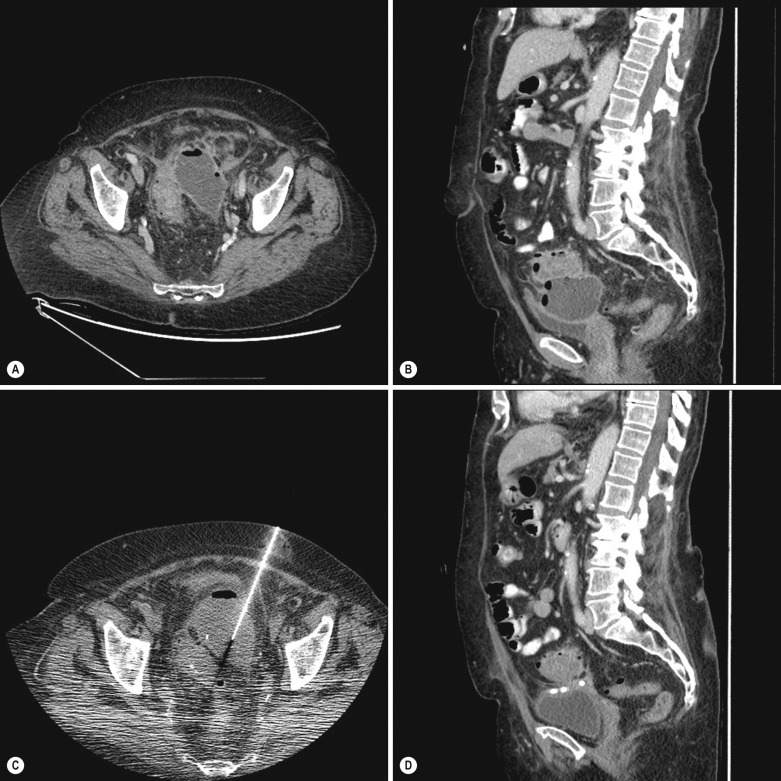
In general, coagulopathies should be corrected before drainage. The bleeding risk of different drainage procedures are stratified into three categories: low, medium and high risk (as Table 82.1 ).
| Low Risk | Medium Risk | High Risk |
|---|---|---|
|
|
|
Consensus guidelines recommend the correction of abnormal coagulation indices for a low-risk procedure if the platelet count is less than 50,000/µL and the international normalised ratio (INR) exceeds 2, or for a medium-risk procedure if the platelet count is less than 50,000/µL and the INR exceeds 1.5. Correction is mandatory prior to a high-risk procedure if the platelet count is less than 50,000/µL and the INR exceeds 1.5 or the partial thromboplastin time is 1.5 times normal. Recommendations for the management of aspirin and clopidogrel therapy prior to low-, medium- and high-risk procedures are highlighted in Table 82.2 .
| Medication | Low-Risk Procedure | Medium-Risk Procedure | High-Risk Procedure |
|---|---|---|---|
| Aspirin | Do not stop | Do not stop | Stop for 5 days before procedure |
| Clopidogrel | Stop for 5 days before procedure | Stop for 5 days before procedure | Stop for 5 days before procedure |
The recent introduction of novel oral anticoagulant medications, including rivaroxaban and apixaban, has introduced a new complexity for interventionists who are trying to minimise the bleeding risk before percutaneous drainage procedures. The patient's INR is not a reliable indicator of bleeding risk in this cohort. The risk of bleeding is stratified by procedure, as in Table 82.1 . In general, these medications need to be held for at least 24 hours before a procedure with a low to medium risk, and for 48 hours before a procedure with a high bleeding risk. However, these recommendations require modification in patients with impaired serum creatinine clearance. Antidotes for these medications are, as yet, not widely available. However, the risk of thrombosis and its implications should also be considered in each individual patient, prior to withholding their anticoagulant medication. In complex cases, close discussion between the radiologist and the referring clinician is required to ensure the optimal approach for the individual patient.
The appropriate management of each patient's coagulation status is crucial to minimise risk in image-guided drainage procedures.
The bleeding risk associated with each procedure is broadly categorised into low, medium and high risk.
Anticoagulant medication use is adjusted accordingly based on the level of risk.
The introduction of the novel oral anticoagulant class of medication has introduced a new level of complexity.
The interventionist should be aware that blood indices are a poor indicator of the activity of these medications and that they should be held for 24 hours in low- to medium-risk drainage procedures and for 4 hours in high-risk procedures.
Preliminary evaluation of an abscess or collection is typically performed by computed tomography (CT) or magnetic resonance imaging (MRI), which optimally demonstrates the abscess location and the adjacent structures, and enables selection of the preferable route for drainage. A disadvantage of CT in this setting is that loculation and complexity of collections are often incompletely appreciated ( Fig. 82.2 ). Ultrasound and CT are primarily used as guidance modalities for the subsequent drainage procedure. The decision to drain an abscess under ultrasound or CT guidance is predominantly based on the location of the abscess, the size of the abscess and operator preference.
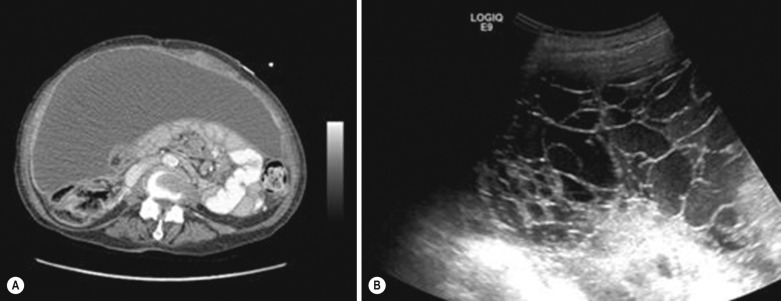
Modern ultrasound provides excellent real-time visualisation of superficial structures, and good visualisation of the viscera and collections. This facilitates careful monitoring, and allows real-time manipulation of a catheter or needle as they are guided into a collection, irrespective of the plane of angulation. Ultrasound is generally used for solid-organ abscesses or for larger abdominal collections. Ultrasound is less useful for guidance if a collection contains air (due to its inability to penetrate gaseous interfaces) or if there are bowel loops adjacent to a collection, which may prevent adequate visualisation and may increase the risk of bowel injury (see Fig. 82.1 ). Ultrasound guidance is preferred in paediatric patients for whom radiation exposure should be minimised, and can also be performed at the bedside ( Fig. 82.3 ). It is important to maintain the needle or catheter in the plane of imaging when using ultrasound. If possible, a needle-probe angle of 55 to 60 degrees should be maintained to optimise reflection of the ultrasound beam and needle or catheter visualisation. It may be useful to utilise ultrasound in association with other imaging modalities for some collections. Combined with fluoroscopy, ultrasound guidance can enable drainage catheter placement into a large or partially visualised collection, before optimal catheter manipulation and positioning by fluoroscopic guidance. Fluoroscopic guidance is also beneficial for placement of catheters using the Seldinger technique and reduces the risk of losing access and kinking the guidewire.
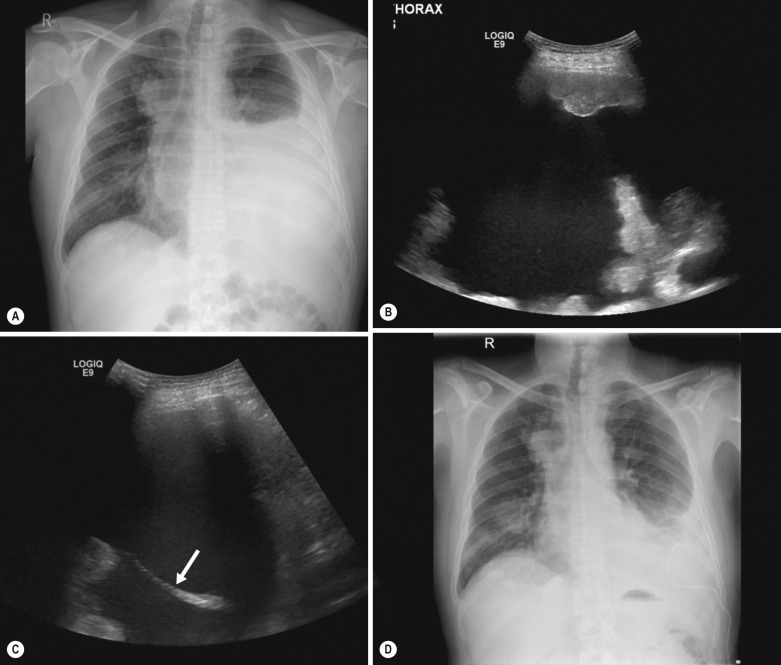
CT-guided fluoroscopy is predominantly used in situations where the collection is poorly seen with ultrasound. CT provides excellent anatomic delineation, irrespective of the overlying structures. It has many proponents, because it offers potential real-time guidance and excellent spatial resolution, which can reduce procedure time. CT fluoroscopy can be performed real time or by using a quick-check method. Real-time guidance involves holding the needle or catheter with a clamp and imaging the catheter or needle as they are advanced. However, quick-check CT guidance is more commonly utilised, and it images the needle tip after manipulation ( Fig. 82.4 ). Quick-check guidance considerably reduces fluoroscopic time and radiation dose compared with real-time guidance. Conventional CT guidance is favoured over ultrasound for the drainage of deep collections that have a difficult percutaneous access window. The superior spatial resolution of CT over ultrasound often allows better localisation of the margins of a collection, the thickness of the wall, the adjacent organs and the access route. Tilting the angle of the CT gantry in a cranial or caudal direction is a useful adjunct, which can help to image a safe direct route of access into a collection that is not available in the axial plane. However, this can create an additional level of difficulty for the interventional radiologist; the gantry laser guide is very useful for catheter direction in this circumstance. Room time, available resources, user preference and experience have a determining impact on the choice of image guidance. Cone-beam CT, where available on modern angiography units, allows the acquisition of three-dimensional volumetric images in the interventional suite. Software fusion packages then allow this volumetric data to be superimposed on live fluoroscopic images. This technique has been shown to be equivalent to conventional CT guidance for drain placement with reduced procedure time.
The appropriate choice of imaging modality to guide each drainage procedure is crucial to ensure safe and effective drain placement.
The evaluation of pre-procedural cross-sectional imaging allows the interventionist to plan each procedure based on the intended target and adjacent structures.
Ultrasound allows dynamic real-time high-resolution imaging and is widely available. However, ultrasound is limited in cases where there is air within a collection or there are adjacent bowel loops.
Computed tomography (CT) provides excellent anatomical delineation and spatial resolution in these cases. However, the type of dynamic needle manipulation possible with ultrasound is less feasible in CT, where imaging is performed in a single axial plane.
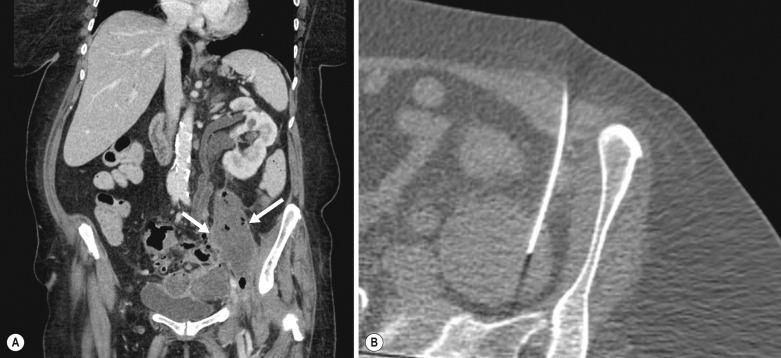
Pre-procedure planning is the crucial step of any procedure to avoid potential complications. The Society of Interventional Radiology recommends broad-spectrum antibiotic prophylaxis to be administered within 1 hour of commencement of a drainage procedure (local or national guidelines should direct the antibiotic of choice for the individual procedure to ensure adequate sensitivity). This does not preclude the microscopy and culture of material from an abscess, since the rind of tissue that surrounds an abscess excludes most abscesses from the normal circulation. The timing of antibiotic administration is important, as the incidence of infectious complications can increase fivefold when antibiotic prophylaxis is initiated more than 3 hours before the actual procedure.
Written informed consent is an important aspect of image-guided drainage. Optimal informed consent entails description of the indications for image-guided drainage, the alternatives, the procedure itself, potential complications and also the expected treatment plan after drainage. As drainage catheters often remain in place for weeks, it is important that the patient is made aware of this so as to avoid unrealistic expectations. Normally, the presence of a nurse, sedation and continuous monitoring of vital signs are required for image-guided drainage. While departments differ in their guidelines regarding how long a patient should fast prior to these procedures, it is recommended that patients should have an empty stomach prior to the administration of conscious sedation and therefore fasting times similar to those employed prior to general anaesthesia are appropriate—no solids for 6 hours, and no fluids for 2 hours. The authors normally use fentanyl citrate and midazolam supplemented by antiemetics where appropriate. Typically, fentanyl is administered in 25 µg aliquots and midazolam is administered in 0.5–1 mg aliquots until appropriate sedation is achieved. General anaesthesia is required for paediatric patients and severely ill or uncooperative patients. The authors advocate 4 hours close observation after drainage to assess for complications ( Table 82.3 ).
|
The following paragraphs provide an overview of the techniques used for generic image-guided drainage. Drainage procedures that require special techniques or considerations will be discussed later in the chapter. Percutaneous aspiration is less likely to treat an abscess adequately compared with drainage catheter insertion. Complete evacuation of an abscess is achieved in only 60% of cases when aspiration is performed, as opposed to 100% of cases where a catheter is placed. A collection that communicates with the bowel or biliary or urinary tracts should not be treated by aspiration. Occasionally, a small collection inaccessible to catheter insertion, such as an interloop abscess in an immunosuppressed patient with Crohn's disease, may be treated by percutaneous aspiration; otherwise, drainage catheter insertion is favoured.
CT-guided catheter placement is generally performed using either the tandem-trochar technique or the Seldinger technique. The tandem-trochar technique relies on the placement of a catheter containing a hollow stiffener and a diamond-pointed stylet, parallel to a guide needle, into a collection ( Fig. 82.5 ). Trochar catheters are available from 8 F to 16 F in size. The authors normally use a hydrophilic-coated Ultrathane catheter with a locking loop (Cook, Bloomington, IN) for image-guided drainage. A CT scan, with a radiopaque grid on the patient's skin, is performed. This enables a safe route for needle and catheter placement to be chosen. The distance from the skin surface to the abscess is measured, and a 20-G guide needle of appropriate length is chosen. The portion of the needle outside the skin needs to be long enough to guide the trajectory of the catheter. Following cleansing and local anaesthetic administration, the needle is placed through the skin into the collection and a sample is obtained for culture. This sample also allows assessment of the viscosity of the collection. The collection should not be aspirated any further until the catheter has been placed. A 10–12-F drainage catheter is usually necessary if the contents are frank pus; an 8–10-F catheter may be adequate for less viscous fluid. The distance from the skin to the contents of the collection should be marked on the catheter. Following a skin incision and tissue separation adjacent to the guide needle, the catheter is introduced parallel to the guide needle, to the level of the mark on the catheter. If unsure as to whether the catheter is in the collection, the sharp metal stylet can be removed and aspiration of fluid will confirm the catheter tip location. The catheter may then be advanced over the stiffener or the stiffener withdrawn and the retention pigtail formed.

Once adequate catheter position is confirmed, the contents of the collection are evacuated, the catheter is secured to the skin with an adhesive device or via skin suture, and a drainage bag is attached. Catheter irrigation at the time of abscess drainage using normal saline can increase drainage yield, disrupt adhesions and improve healing time. However, the volume of normal saline injected must not exceed that of the fluid drained from the collection to prevent cavity distension and to reduce the risk of bacteraemia. The tandem-trochar technique is fast, does not require serial dilatation, and the metal stiffener affords good catheter directionality. It should be noted that some collections have tough fibrous walls, which can deflect the catheter. A malpositioned catheter will usually need to be withdrawn and replaced.
The Seldinger technique enables more controlled catheter placement, especially if there is a high risk of catheter transgression of the posterior wall of a collection ( Fig. 82.6 ). The Seldinger technique can also facilitate better drainage of large multiloculated collections by placement of a multi-sidehole catheter. A 19-G ultrathin needle containing a stylet or a sheathed needle is placed initially into the collection. An 0.035-inch guidewire is advanced through the needle or sheath and, once adequate positioning is confirmed, the tract is serially dilated and the final catheter placed. The Seldinger technique is time-consuming and tract dilatation can be painful, especially when traversing muscles. Dilatation also carries an increased risk of spillage of the abscess contents outside the abscess cavity during dilator exchange and before catheter placement. Manipulation of a dilator over the wire in a confined space also carries a risk of buckling the guidewire, which can hinder catheter placement.
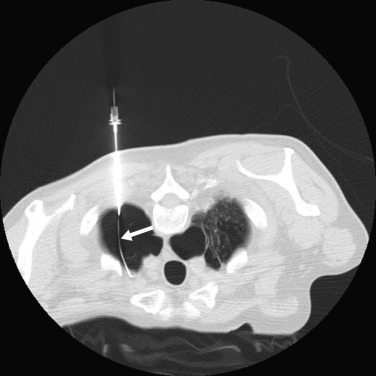
Ultrasound-guided catheter insertion is performed under direct guidance following skin preparation. A guide needle is not necessary, unless one wishes to sample contents of the collection to assess consistency before choosing the catheter size ( Table 82.4 ).
|
Drainage catheters should be flushed with normal saline every 8–12 hours to maintain catheter patency and to optimise drainage. A flush volume of 5 ml towards the patient and 5 ml towards the drainage bag via a three-way stopcock is normally sufficient, unless a collection is very small or very large. Daily catheter outputs should be monitored and the contents of the drainage bag should be noted. This may alert one to evolving issues such as fistulisation or bleeding. In addition, difficulty flushing the catheter, pain on flushing and catheter withdrawal can signal blockage or displacement ( Fig. 82.7 ). Contrast material injection into the catheter under fluoroscopic guidance is generally indicated in these circumstances. Catheter removal is considered in a well patient when daily outputs are low, normally on the order of 10 ml or less per day. Before catheter removal, if there is concern with regard to the adequacy of drainage or there are persisting clinical symptoms, complete drainage of the collection can be confirmed by CT or ultrasound imaging. However, if the patient has improved clinically and inflammatory indices have normalised, the catheter can simply be removed. Injection of contrast material per catheter can be performed if there is clinical suspicion that a fistula to bowel has developed. Optimal drainage and complication avoidance are best achieved by active participation of the interventional radiologist in patient and drainage catheter management.
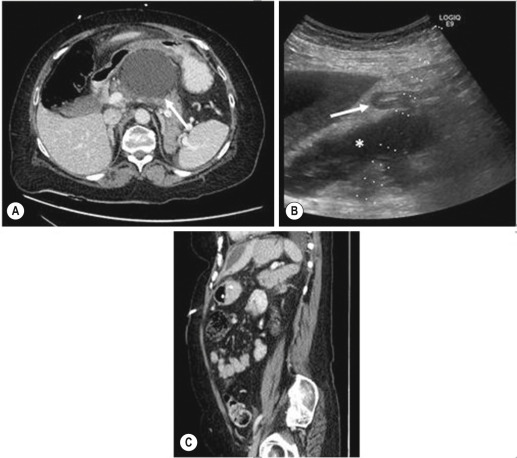
Become a Clinical Tree membership for Full access and enjoy Unlimited articles
If you are a member. Log in here